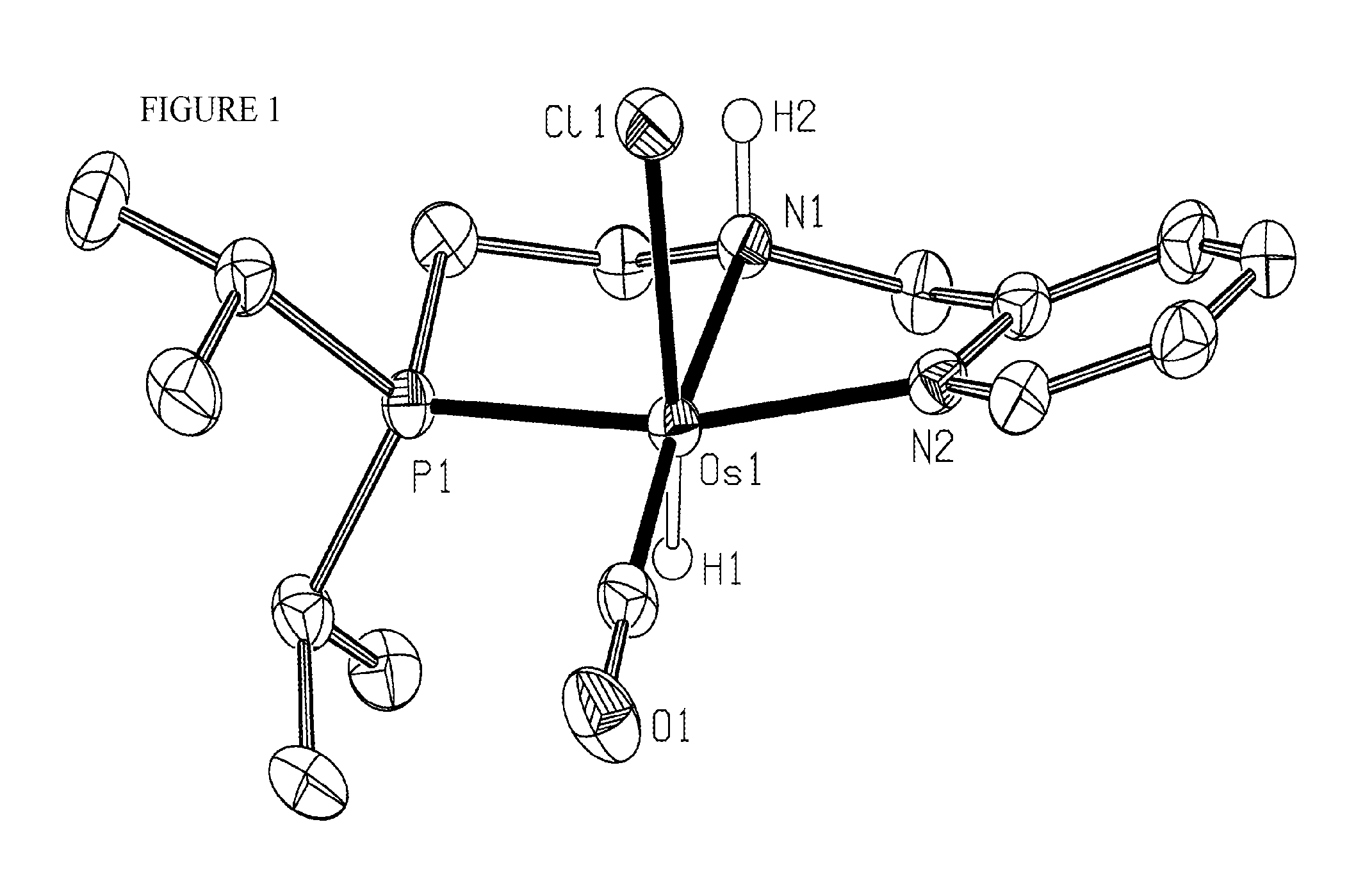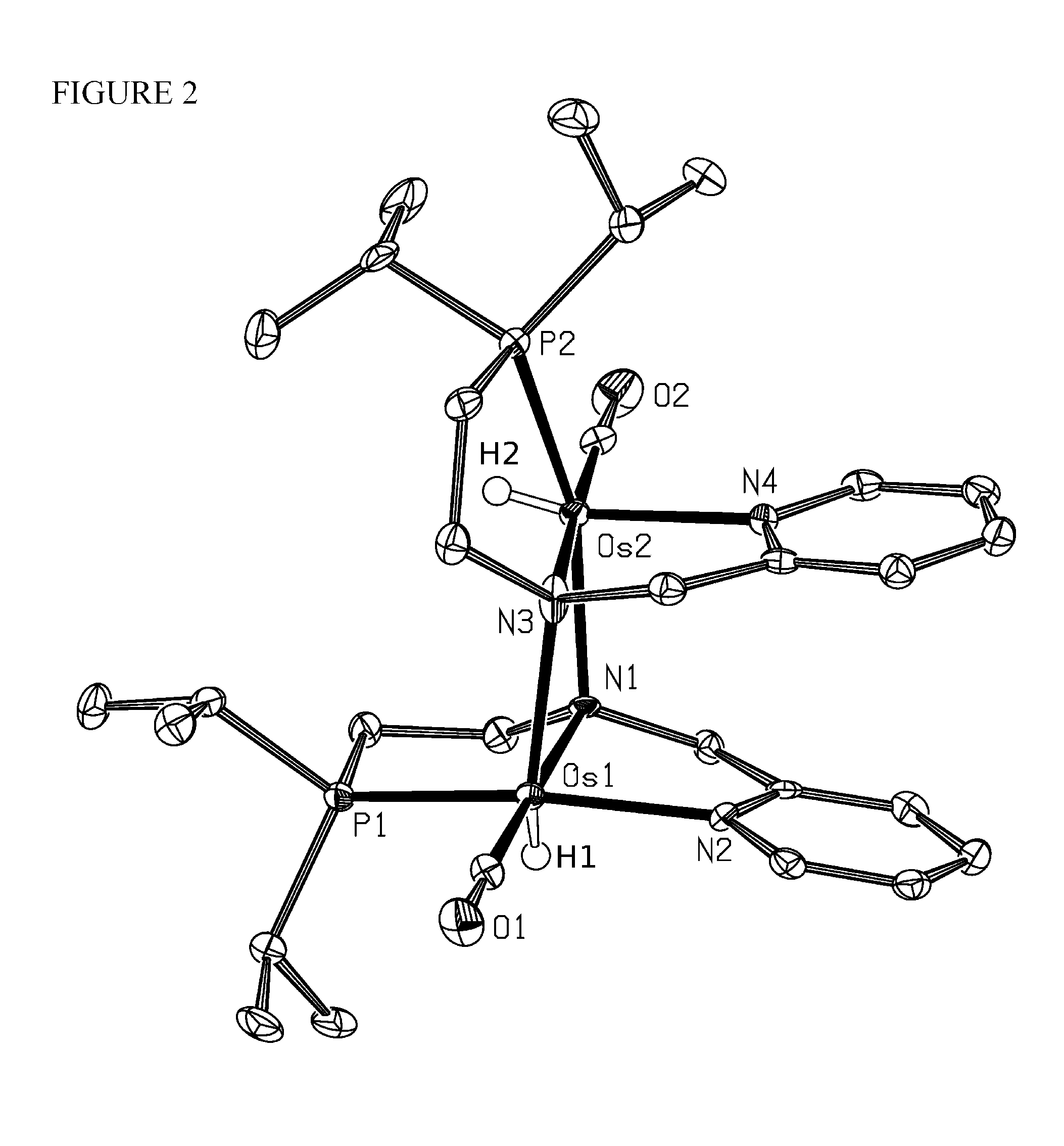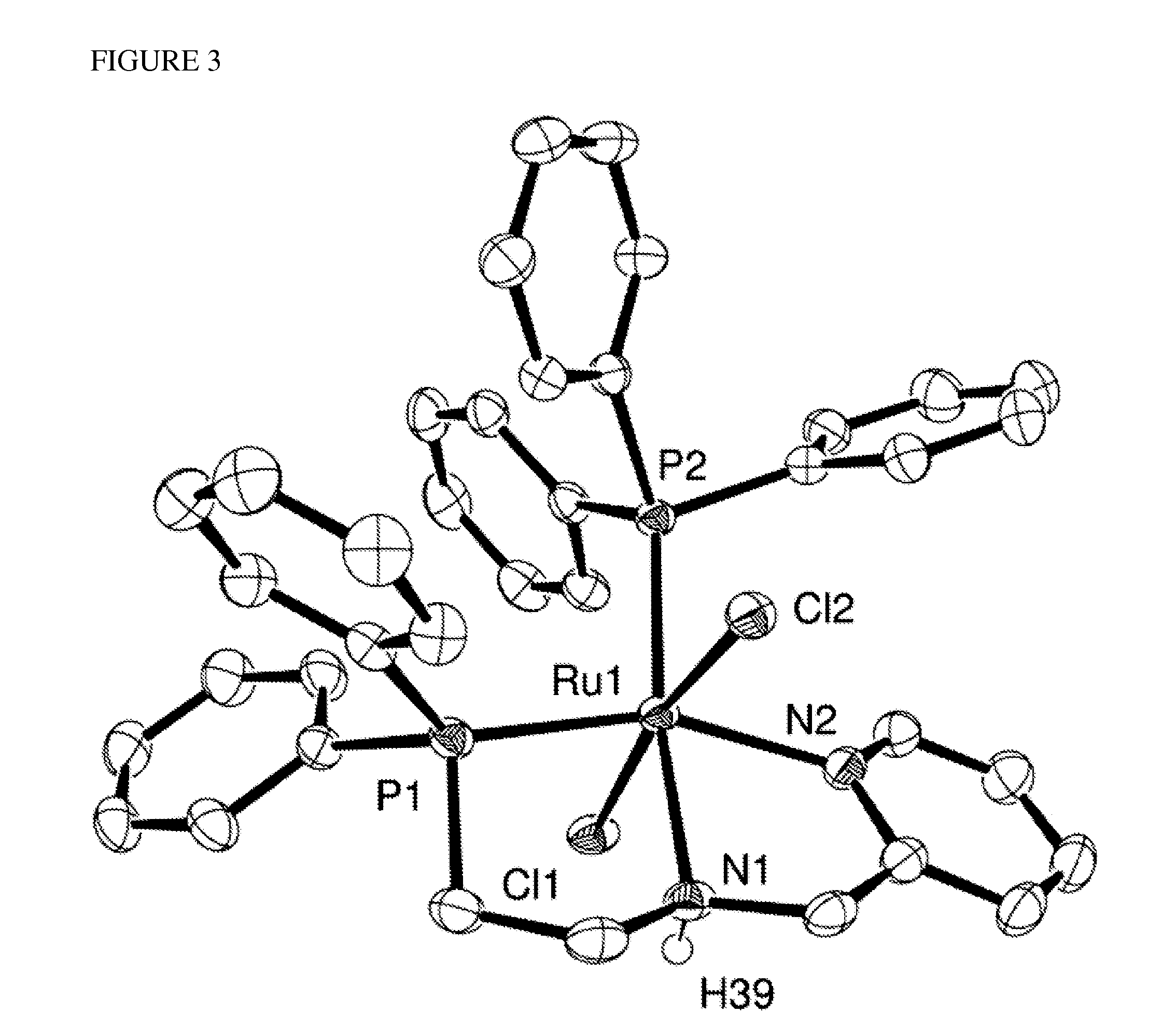Hydrogenation and dehydrogenation catalyst, and methods of making and using the same
a technology of hydrogenation and dehydrogenation catalyst, which is applied in the field of catalysts, can solve the problems of large amount of chemical waste, inconvenient and expensive use of hydride reducing reagents, and hydride reduction methods
- Summary
- Abstract
- Description
- Claims
- Application Information
AI Technical Summary
Benefits of technology
Problems solved by technology
Method used
Image
Examples
example 1
Synthesis of PyCH2NH(CH2)2N(iPr)2
[0081]2-aminoethyl diisopropylamine (6.32 g, 0.044 mmol) was added to 2-picolyl aldehyde (4.70 g, 0.044 mmol) and the mixture was stirred for 1 h. The obtained imine was diluted with methanol (15 mL) and NaBH4 (1.66 g, 0.044 mmol) was added portion-wise during 1 h. Then, all volatiles were removed under vacuum, and the residue was re-dissolved in 20 mL of dichloromethane. The solution was filtered through a short pad (3×2 cm) of Al2O3. The aluminum oxide was then washed with 10 mL of dichloromethane and the collected filtrate was evaporated and dried under vacuum for 1 h. The product was obtained as a yellow oil (8.41 g, 90%).
[0082]1H NMR (300 MHz, CDCl3) δ=8.47 (ddd, J=4.8, 1.8, 0.9 Hz, 1H), 7.73 (td, J=7.6, 1.8 Hz, 1H), 7.39 (d, J=7.8 Hz, 1H), 7.21 (ddd, J=7.5, 4.9, 1.2 Hz, 1H), 3.77 (s, 2H), 3.33 (br., 1H, NH), 2.97 (sep, J=7.0, 2H; CH), 2.48 (m, J=2.5 Hz, 4H, CH2), 0.92 (d, J=6.6 Hz, 12H; 4×CH3). 13C NMR ([D6]DMSO) δ=160.62 (s, 1C; Py), 148.75 (...
example 2
Synthesis of PyCH2NH(CH2)2P(iPr)2
[0083]2-picolyl aldehyde (1.66 g, 0.0155 mmol) in 10 mL of THF was added to a 10 wt % solution of 2-(di-i-propylphosphino)ethylamine in THF (26.0 g, 0.0162 mmol) and the mixture was stirred for 1 h. The obtained imine was then treated with diisobutyl aluminum hydride (22.7 mL, 1.5 M in toluene, 0.0341 mmol) during 1 h (Caution!!! Exothermic reaction!) and left to stir for 1 h. After that time, the solution was quenched with 1 mL of water (Caution!!! Exothermic reaction!) and the obtained suspension was filtered through a short pad (3×2 cm) of basic alumina. The solids were washed with THF (3 ? 10 mL) and the collected filtrate was evaporated and dried under vacuum for 3 h. The product was obtained as a yellow oil (2.84 g, 73%).
[0084]31P{1H} NMR ([D6]Benzene) δ=−1.0 (s). 1H NMR ([D6]Benzene) δ=8.49 (dt, J=4.7, 1.8 Hz, 1H; Py), 7.15-7.13 (m, 1H; Py), 7.09 (td, J=7.7, J=1.8 Hz, 1H; Py), 6.64 (ddd, J=7.0, 4.9, 1.7 Hz, 1H; Py), 3.93 (s, 2H; PyCH2), 2.81 ...
example 3
Synthesis of trans-OsHCl(CO)[PyCH2NH(CH2)2P(iPr)2]
[0085]
[0086]A flask containing a mixture of OsHCl(CO)(AsPh3)3 (5.94 g, 5.57 mmol) and PyCH2NH(CH2)2P(iPr)2 (1.27 g, 5.06 mmol) in 15 mL of diglyme was placed in a preheated to 160° C. oil bath and stirred for 1 h, affording a dark-red solution. After cooling to room temperature, the mixture was diluted with 4 mL of diethylether, and the flask was stored overnight in a freezer at 18° C. The precipitated product was filtered off, washed with diethyl ether (3×3 mL), and dried under vacuum for 3 h to give a brown crystalline solid. Yield: 1.81 g (71%).
[0087]31P{1H} NMR ([D2]DCM) δ=48.41 (s). 1H{31P} NMR ([D2]DCM) δ=9.00 (d, J=5.5 Hz, 1H, Py), 7.68 (td, J=7.8, 1.5 Hz, 1H, Py), 7.28-7.16 (m, 1H, Py), 4.61 (dd, J=14.3, 4.4 Hz, 1H, PyCH2), 4.12 (br. t, J=12.0 Hz, 1H, NH), 3.93 (dd, J=14.2, 11.6 Hz, 1H, PyCH2), 3.67-3.58 (m, 1H, NCH2), 2.73-2.53 (m, 1H, NCH2), 2.46 (sep, J=14.7, 7.4 Hz, 1H, PCH), 2.37 (dd, J=15.0, 4.0 Hz, 1H, CH2P), 2.11 (sep...
PUM
| Property | Measurement | Unit |
|---|---|---|
| temperature | aaaaa | aaaaa |
| temperature | aaaaa | aaaaa |
| temperature | aaaaa | aaaaa |
Abstract
Description
Claims
Application Information
 Login to View More
Login to View More - R&D
- Intellectual Property
- Life Sciences
- Materials
- Tech Scout
- Unparalleled Data Quality
- Higher Quality Content
- 60% Fewer Hallucinations
Browse by: Latest US Patents, China's latest patents, Technical Efficacy Thesaurus, Application Domain, Technology Topic, Popular Technical Reports.
© 2025 PatSnap. All rights reserved.Legal|Privacy policy|Modern Slavery Act Transparency Statement|Sitemap|About US| Contact US: help@patsnap.com



